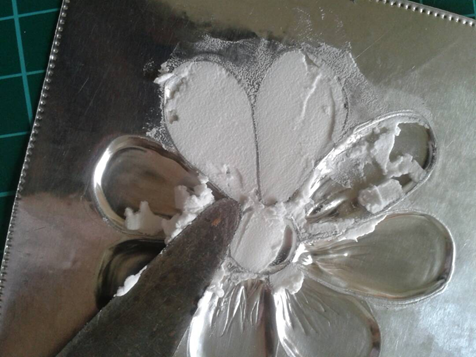BASIC GUIDE FOR REPUJADO IN METAL PART 8
Hello steemit community, if you have followed me until this moment I can not stop commenting on other details no less important than the previous ones, for example once we finish embossing the main design in this case the flower, either with the form of ironing or shoveling which we have previously worked, it is essential to fill each petal of the flower, in order to prevent the relief that we generated in the metal sheet from sinking when we manipulate it, but first we must make some details to each petal.
Step 1. As we have been working, remember that a hard surface like wood or glass is necessary, and another soft one like a sheet of paper folded in one or more parts, or a sheet of foamy as some manualitas or artisans do, I personally like to use the folded sheet, we will also use the profiler as a tool.
Step 2. Then on the back of the aluminum sheet we will gently support the profiler on the edge of the center of the flower and towards the petal, with a very loose movement we will pass several lines that will give it a little movement and resemblance to the real flowers.

Step 3. Little by little we are generating more petals by petals, we can turn the sheet to the right to see if we are achieving the desired effect.

Step 4. We can leave it with fewer lines like the flower that we will see next.

Step 5. Or, on the contrary, add more lines as the next picture.

Step 6. Once we finish the finish of the flower, now if we are going to fill each petal of the flower.
In the artistic or specialized stores, there are several brands of special pastes to fill the metal sheets after they are embossed, so we will need a spatula, a sandpaper and a damp cloth.

Step 7. With the tip of the spatula you take a small amount of the special stuffing paste, and you deposit it in each petal.




Step 8. When you finish filling all the petals, you can see that around the flower is a little daubed with the paste that we just used, that excess can be easily removed with a damp cloth, sliding it gently on the surface trying to leave it as clean as possible.



Step 9. In case there are still residues of the paste, we will finish removing it with a very fine grit sandpaper.

Step 10. With a smooth and circular movement we pass the sandpaper, leaving the surface clean and ready to stick it on the surface previously chosen by you.

As always I advance you in the next guide with the application of paint, patinas and fixing the metal sheet on the surface of your preference.
Guide written by @erondon
Congratulations! This post has been upvoted from the communal account, @minnowsupport, by erondon from the Minnow Support Project. It's a witness project run by aggroed, ausbitbank, teamsteem, theprophet0, someguy123, neoxian, followbtcnews, and netuoso. The goal is to help Steemit grow by supporting Minnows. Please find us at the Peace, Abundance, and Liberty Network (PALnet) Discord Channel. It's a completely public and open space to all members of the Steemit community who voluntarily choose to be there.
If you would like to delegate to the Minnow Support Project you can do so by clicking on the following links: 50SP, 100SP, 250SP, 500SP, 1000SP, 5000SP.
Be sure to leave at least 50SP undelegated on your account.